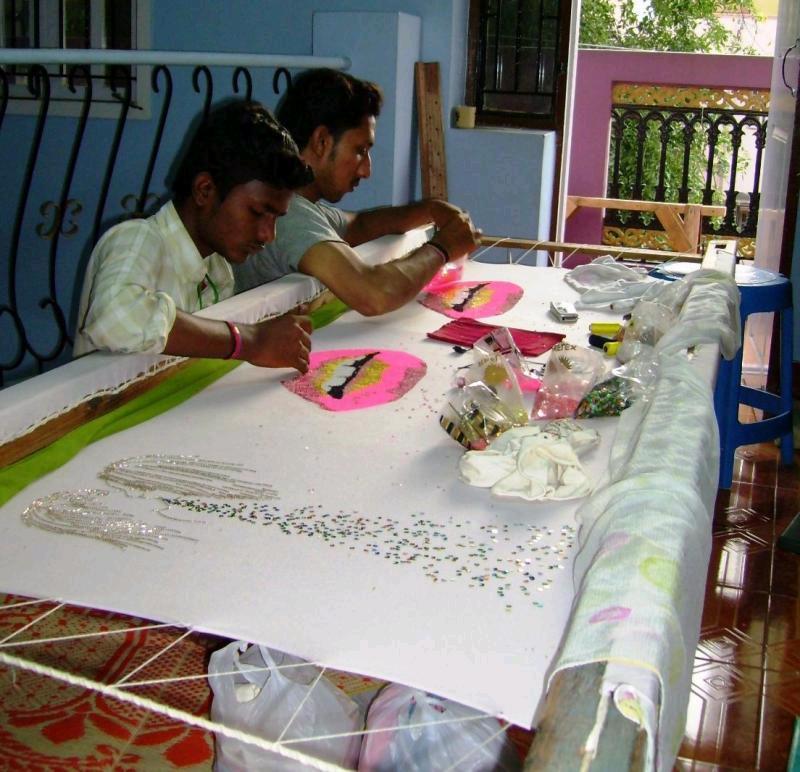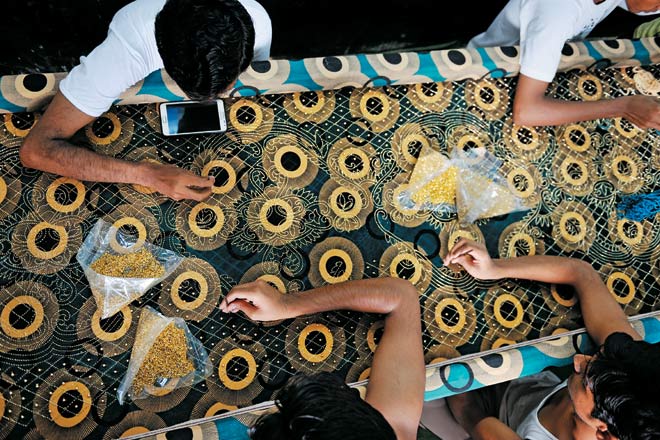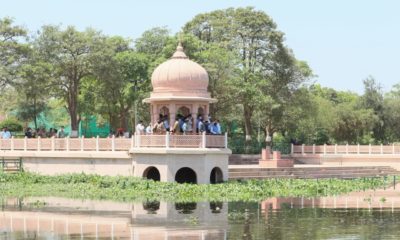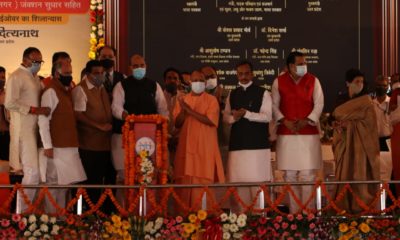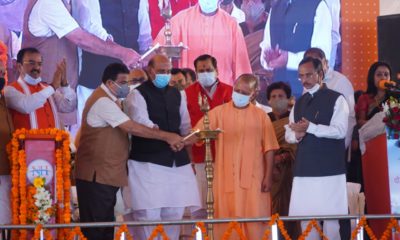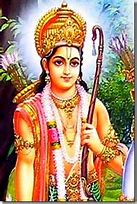Feature
Hand skill used in ‘zardozi’ work, now runs E-rickshaws in Lucknow
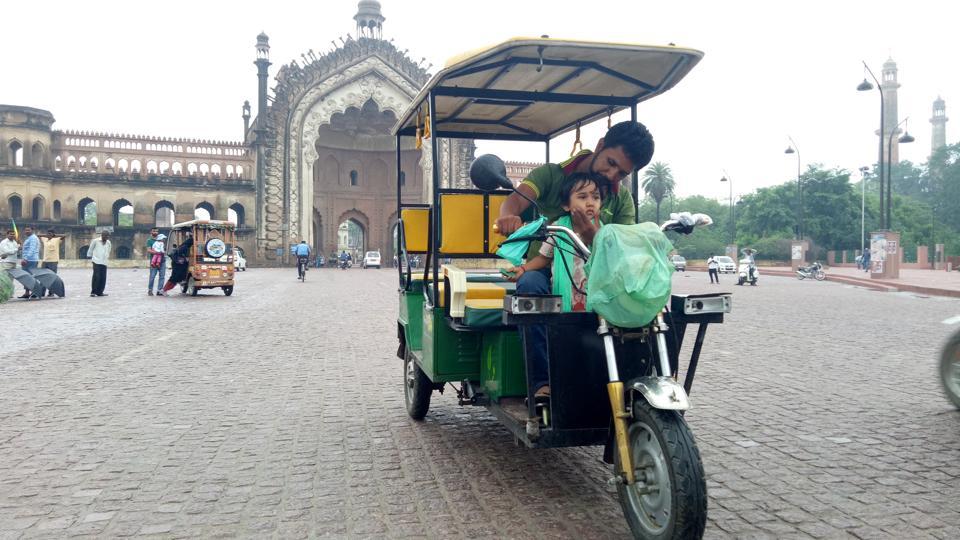
Lucknow: The hands that earlier crafted beautiful designs on clothes with gold and silver threads are now ferrying people on e-rickshaws these days braving harsh weather conditions.
But life is still better for these former zardozi workers as they are now able to make both ends meet. Involved in zari and zardozi work for generations, Chandu Ali, 40, has now quit his family profession and runs an e-rickshaw in old city. Low wages, less work and poverty made Chandu switch his job.
“Zardozi was in my blood. My entire family was involved in embroidery for generations. I too had mastered the art form during my childhood. However, the condition of artisans is getting from bad to worse. Day long work wouldn’t ensure more than Rs 100-125 which is too little to feed the family,” says Chandu, father of three.
And Chandu isn’t alone. A number of workers known for their skill are pulling rickshaws and doing other menial jobs.
“Skill is the gift of Allah and we were the blessed ones to have it. I was known for neatness in my work and worked on lehengas and heavy embroidered sarees that were sold in big showrooms. Our works sold for thousands of rupees but we were paid only Rs 100-150 per day which was too meager,” another artisan Jawed says.
When e-rickshaws were introduced in Lucknow a couple of years ago, artisans like Jawed took up driving. “I now earn a minimum of Rs 500-600 per day. My children are enrolled in a private school,” he says.
Jawed, however, never misses an opportunity to take tourists to the by lanes and show them ‘zardozi addas’ where artisans work under dim light and poor conditions.
“More artisans are quitting and the art would die a slow death one day. I often take tourists on my rickshaw to show them the reality of zardozi artisans with the hope that one day someone would change their fate,” Jawed says.
Like zardozi workers, people skilled in making murri and aari motifs of chikankari are also joining the profession.
“It is more than a year now that I am driving e-rickshaw. My father was also a chikankari worker as is ill and old now. He couldn’t accept me driving a rickshaw and showed me the door. I live separately with my wife and son now,” says Sachin.
Injustice to artisans is what made him quit chikankari. “We may speak highly about handicraft but the reality is that artisans never get respect and money. I incurred losses when a fire broke out at Delhi Haat. The government promised compensation but we did not get anything. I did not have money to begin work afresh and thus decided to drive a rickshaw,” he says.
Ali Agha, spokesman of an association of zardozi workers, said, “The day is not far when there wouldn’t be any artisans left. Those involved in embroidery for generations are quitting and do not want their children to learn zardozi. Growing popularity of machine work and unfair remuneration for hard work is killing the artisans.”
Entertainment
Meghalaya Reserves Legalized Gambling and Sports Betting for Tourists

The State Scores Extra High on Gaming-Friendly Industry Index
Meghalaya scored 92.85 out of 100 possible points in a Gaming Industry Index and proved to be India’s most gaming-friendly state following its recent profound legislation changes over the field allowing land-based and online gaming, including games of chance, under a licensing regime.
The index by the UK India Business Council (UKIBC) uses a scale of 0 to 100 to measure the level of legalisation on gambling and betting achieved by a state based on the scores over a set of seven different games – lottery, horse racing, betting on sports, poker, rummy, casino and fantasy sports
Starting from February last year, Meghalaya became the third state in India’s northeast to legalise gambling and betting after Sikkim and Nagaland. After consultations with the UKIBC, the state proceeded with the adoption of the Meghalaya Regulation of Gaming Act, 2021 and the nullification of the Meghalaya Prevention of Gambling Act, 1970. Subsequently in December, the Meghalaya Regulation of Gaming Rules, 2021 were notified and came into force.
All for the Tourists
The move to legalise and license various forms of offline and online betting and gambling in Meghalaya is aimed at boosting tourism and creating jobs, and altogether raising taxation revenues for the northeastern state. At the same time, the opportunities to bet and gamble legally will be reserved only for tourists and visitors.
“We came out with a Gaming Act and subsequently framed the Regulation of Gaming Rules, 2021. The government will accordingly issue licenses to operate games of skill and chance, both online and offline,” said James P. K. Sangma, Meghalaya State Law and Taxation Minister speaking in the capital city of Shillong. “But the legalized gambling and gaming will only be for tourists and not residents of Meghalaya,” he continued.
To be allowed to play, tourists and people visiting the state for work or business purposes will have to prove their non-resident status by presenting appropriate documents, in a process similar to a bank KYC (Know Your Customer) procedure.
Meghalaya Reaches Out to a Vast Market
With 140 millions of people in India estimated to bet regularly on sports, and a total of 370 million desi bettors around prominent sporting events, as per data from one of the latest reports by Esse N Videri, Meghalaya is set to reach out and take a piece of a vast market.
Estimates on the financial value of India’s sports betting market, combined across all types of offline channels and online sports and cricket predictions and betting platforms, speak about amounts between $130 and $150 billion (roughly between ₹9.7 and ₹11.5 lakh crore).
Andhra Pradesh, Telangana and Delhi are shown to deliver the highest number of bettors and Meghalaya can count on substantial tourists flow from their betting circles. The sports betting communities of Karnataka, Maharashtra, Uttar Pradesh and Haryana are also not to be underestimated.
Among the sports, cricket is most popular, registering 68 percent of the total bet count analyzed by Esse N Videri. Football takes second position with 11 percent of the bets, followed by betting on FIFA at 7 percent and on eCricket at 5 percent. The last position in the Top 5 of popular sports for betting in India is taken by tennis with 3 percent of the bet count.
Local Citizens will Still have Their Teer Betting
Meghalaya residents will still be permitted to participate in teer betting over arrow-shooting results. Teer is a traditional method of gambling, somewhat similar to a lottery draw, and held under the rules of the Meghalaya Regulation of the Game of Arrow Shooting and the Sale of Teer Tickets Act, 2018.
Teer includes bettors wagering on the number of arrows that reach the target which is placed about 50 meters away from a team of 20 archers positioned in a semicircle.
The archers shoot volleys of arrows at the target for ten minutes, and players place their bets choosing a number between 0 and 99 trying to guess the last two digits of the number of arrows that successfully pierce the target.
If, for example, the number of hits is 256, anyone who has bet on 56 wins an amount eight times bigger than their wager.

